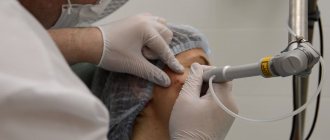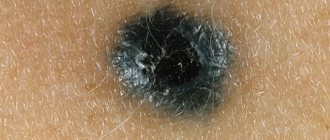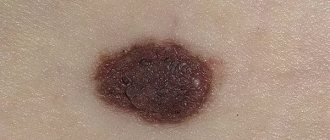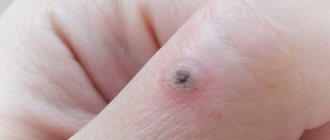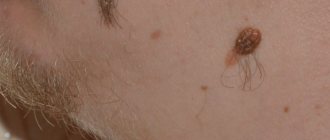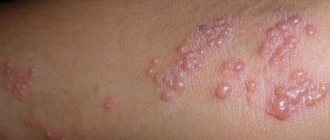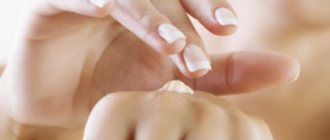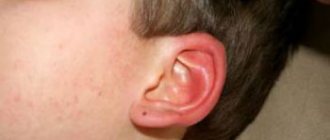Why do moles become inflamed?
A mole is sick, itches and burns - the main signs indicating a malignant degeneration of the neoplasm. The causes of nevus pain are different. These include:
- damage;
- increase and growth;
- sunburn or prolonged exposure to a solarium;
- inflammation;
- uneven outline;
- malignant degeneration.
Degeneration of a mole into melanoma
In cases where your mole begins to change quickly before your eyes, the onset of the development of cancer is most often involved. Signs of a mole degenerating into melanoma include inflammation – redness of the skin around the mole.
A major role in the development of melanoma is played by the possibility of unwanted severing of connections between existing malignant cells, which leads to their spread throughout the body and organs.
Therefore, you need to carefully monitor changes in all your moles in order to begin a timely fight against this disease.
Development of skin cancer
One of the signs of degeneration is an increase in the size of a mole on the body, head or face. If a mole begins to grow, this does not mean that melanoma (skin cancer) has appeared. The reason for the growth may be different, although it is possible that it will give impetus to a serious illness.
- External damage to papillomas and birthmarks. Microtraumas can be caused by shaving, hair removal, combing, and constant friction. Damage to a red mole is especially dangerous: it not only provokes its growth, but is also fraught with severe bleeding.
- Ultraviolet radiation, radiation. Prolonged exposure to the open sun or in a solarium is a common cause of rapid growth of melanocytes (pigmented cells). A brown or black mole increases in size.
- Fluctuations in hormonal levels. It happens that a mole begins to increase during puberty or during pregnancy. It happens that with hormonal surges, a mole on the body becomes smaller or disappears completely.
- Heredity. Often birthmarks in children are found where their ancestors had them. Even the shape and size of the nevus can be duplicated.
What to do if a mole starts to grow. Signs of melanoma
What to do if a mole changes color, grows quickly and itches, and pain is periodically felt in it? If such signs appear or the nevus is damaged, medical consultation is required.
Only a doctor can determine whether it is melanoma and decide whether to remove the mole. If you do not respond to alarming symptoms in time, the tumor grows into adjacent tissues and metastasizes through the blood and lymph.
Causes of moles
The number of birthmarks may increase throughout life. The occurrence of formations can be provoked by the following factors:
- Ultraviolet radiation. Exposure to direct sunlight for a long time can lead to the appearance of new areas of pigmentation, as well as the malignancy of existing moles.
- Hormonal imbalance that occurs even in healthy people during adolescence and pregnancy.
- Violation of the integrity of the epidermis.
- Penetration of infectious agents and viruses into the body.
- Genetic predisposition.
- Impaired functioning of the pancreas or thyroid gland, liver.
- Exposure to radiation.
- Avitaminosis.
Reasons for growth
In ancient times, fate was predicted using such spots, and each birthmark was shrouded in mystical meaning. Beauties of the Middle Ages deliberately decorated prominent parts of the body with artificial dots, the so-called “front sights”, to give their appearance a special chic and flirtatiousness.
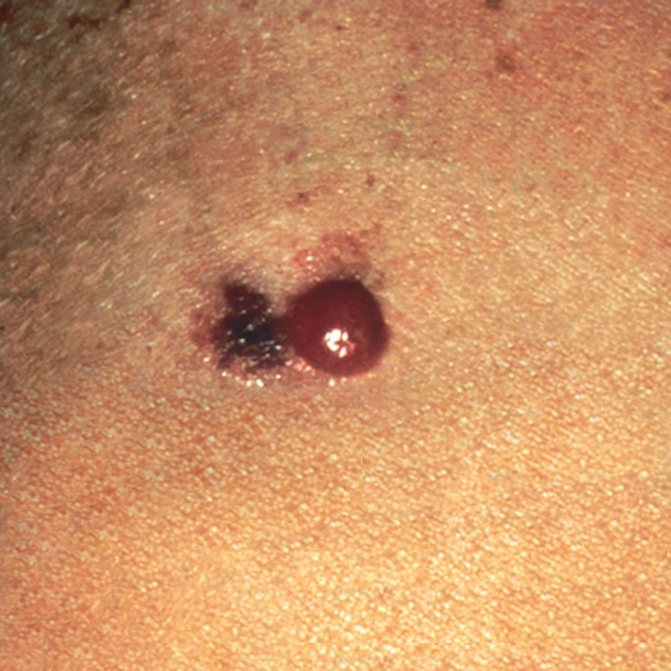
Dermatology today pays considerable attention to such neoplasms on the body that can transform into malignant oncological formations.
A mole (otherwise known as nevus) is a benign formation on human skin. Nevi can be recognized on any part of the body. It is interesting to see such spots on the feet, between the toes, heels, and mucous tissues.
When a mole hurts, an experienced dermatologist or oncologist will immediately determine the nature of the growth during a visual examination. Often, many patients are bothered by large formations protruding above the surface of the skin. The main reasons are considered to be the following:
- trauma (common cause);
- malignant changes in epidermal tissue.
An ordinary formation rarely causes discomfort or pain to its owner. If the edges of the nevus are smooth and the color varies from light brown to dark brown, then we can say that the skin formation is developing normally. But what to do if a mole hurts, becomes inflamed, or begins to cause severe discomfort? Your own observations of changes in nevi can greatly help treatment and speed up the diagnostic stages. Here it is important to consult a doctor and not experiment with traditional medicine recipes to eliminate discomfort. I often study nevi on my own body and pay attention to the following factors:
- gradual increase in size;
- change in pigmentation (unevenness of shade);
- the presence of colored inclusions inside the nevus;
- blurred contours;
- change in the thickness of the formation;
- the growth of a mole in breadth or upward.
If these changes are accompanied by pain, this may indicate a pathological deformation of the tissue in the area where the nevus is located. Interestingly, the largest moles tend to be on prominent parts of the body (face, neck, hairline).
You should definitely pay attention not only to the nature of the nevus, but also to their location and symptoms of discomfort in addition to pain.
The main reasons for the redness of the mole itself or the skin around it are its mechanical damage or malignancy.
A mole can be damaged by tight clothing with rough seams, when washing the body with a hard washcloth, when scratching, etc.
The reasons why a mole hurts can be injury, exposure to ultraviolet radiation, inflammation and degeneration of a nevus.
Injury
Trauma may be the reason why a mole becomes painfully inflamed. Sometimes these growths are placed rather poorly, and the wearer can often rub them against clothing, shoulder straps, waistbands or belts.
Pigmented growths growing under the armpit or in the groin can be touched when shaving. Nevi located on the neck and back are often injured by careless movements or when rubbed with a washcloth.
Flat nevi or spots that look harmless can be damaged by shaving or waxing. Therefore, if you are a man and a mole on your face hurts, perhaps the reason lies in the fact that you injured it with a razor.
Complications and consequences
Is it possible to squeeze a pimple on a mole? Will this lead to complications?
It is generally not recommended to squeeze pimples, regardless of where exactly they are located. It is especially undesirable to squeeze pimples located on a mole. The fact is that when pressure is applied, the inflammatory process can spread along the periphery and into the depths of the tissue. When the process moves into the subcutaneous fat layer, an abscess develops, which often increases to a significant purulent focus. Necrosis may form in the depths.
All of the above complications can negatively affect the mole itself. A strong inflammatory process damages the tissue of the birthmark, which increases in size, swells, and becomes painful. In this case, the risk of malignant degeneration increases several times.
You can suspect something is wrong in the following cases:
- if the mole has changed its color;
- if a dark or light rim appears around the mole;
- if the mole has become asymmetrical;
- if pimples appear on the mole constantly and in large quantities.
[2], [3], [4]
Main types
There are many varieties of such formations. They are:
- light and dark in color;
- protruding above the surface of the skin and flat;
- deeply embedded in the thickness of the skin and superficial.
Often small moles give a special zest to its owner, but there are times when large formations on the face simply disfigure a person’s appearance.
All types of nevi are conventionally divided into 2 types:
- vascular, which include papillomatous formations and angiomas;
- pigmented, among which are freckles and lentigo (a uniformly pigmented flat spot of brown or black color).
Experts identify the following types of nevi:
- epidermo-dermal (flat or slightly raised above the skin);
- intradermal (rough, smooth and warty, raised above the skin; hair often grows from them);
- dysplastic (irregular in shape, large in size, raised above the skin);
- giant pigmented (such a black mole occupies a large surface).
There are many varieties of such formations, and each can increase in size. Based on their color, moles are:
- light (matching skin color);
- yellow or yellow-brown;
- dark brown or black;
- pink or reddish.
In relation to the skin surface, nevi can be flat or protruding. In structure they are vascular and pigmented.
Their surface may look smooth, rough, or warty. Sometimes hair grows through such a mole.
The shape of the formation can be regular or irregular, the boundaries can be clear or blurry, and in size there are small, medium, large and giant moles.
In the latter case, a birthmark often becomes a big problem for a person, as it spoils his appearance.
Symptoms of a pimple on a mole
The clinical symptoms of acne that grow inside a mole are varied. Most often, acne affects birthmarks located on areas of the skin with a large number of sebaceous ducts - this is the area of the back, face or chest.
The first signs of pimple growth are the appearance of a painful infiltrate inside the nevus. Initially, the compaction looks like a cone-shaped nodule (papule) of a red hue. Over time, the inflammatory reaction increases, the nodule increases in size, and an abscess with white contents (pustule) becomes noticeable in its middle.
After some time, the pimple opens, the pus comes out, and a crust forms on the surface. After the crust falls off, a small scar may remain, but often it is completely invisible.
The entire process of the appearance and regression of a pimple can take about one week.
Is a white pimple on a mole considered dangerous?
In the vast majority of cases, the appearance of a white pimple on a mole has nothing to do with cancer. Only rarely can one suspect a malignant degeneration of a nevus: in this case, the appearance of the mole changes, some discomfort appears, and pimples can appear in this place quite often. A biopsy of a modified formation will unmistakably indicate melanoma.
Signs of danger that require immediate attention
If the patient knows the causes of pain or was preceded by any factors (damage, rubbing with linen, scratching), then it is sufficient to carry out disinfectant therapy with medications or antiseptic solutions (Miramistin, Chlorhexidine aqueous).
If pain persists for a long time, then this is a reason to immediately consult a doctor. The warning signs are as follows:
- itching, bleeding, cracks, increased dryness;
- change in structure, color;
- redness or sharp darkening of the nevus;
- change in shape, size;
- the appearance of purulent or colorless sticky fluid under the tumor.
Many doctors consider any change in a mole a symptom of pathological degeneration. It is very important what place on the body the painful nevus occupies.
There are signs that require special attention when moles hurt badly:
- all forms of modifications that may indicate malignant degeneration;
- a sharp increase in size (width and height);
- change in color of the tumor, accompanied by severe pain;
- irregular shape of the border of the nevus and jagged edges of the neoplasm;
- the appearance of slight bleeding, cracks, roughness and itching;
- sudden appearance of fluid (clear or purulent) in the mole itself or in the surrounding tissues.
If a mole hurts, then such appearances may indicate a malignant degeneration of the nevus, which requires mandatory consultation with an oncologist and further treatment.
There are some other conditions that you definitely need to pay attention to when a mole hurts very much:
- any modifications: they often indicate degeneration;
- sudden increase in height or width;
- darkening or redness of the nevus along with pain;
- changes in color and texture, including the formation of mottling of the surface layer of the birthmark;
- drawing irregular borders and jagged edges on previously normal pigmentation;
- bleeding, itching, roughness, cracks;
- an accumulation of clear or purulent fluid under or near a mole.
Associated symptoms and mechanism of action
Contact your doctor if you have the following symptoms:
- a swollen mole with a change in color (blackened, reddened), shape (ball), size;
- the surface of the neoplasm has become denser, lumpy, and uneven;
- itching, burning;
- formation of small bubbles;
- asymmetrical arrangement;
- discharge of blood, other fluid (pus), inflammation;
- a crust has formed;
- a blister appears next to the nevus;
- hanging birthmark;
- change in skin color around the nevus.
Proper care is required after removal:
- 1-7 days after removal, a dark crust forms, which cannot be removed so as not to introduce infection into the wound. After a week, the dark crust will come off and a pink crust will form. It is not recommended to lubricate damaged skin with decorative cosmetics or drink alcohol (vasodilatation can cause bleeding). It is necessary to treat the skin with antiseptic solutions (carbon peroxide, potassium permanganate).
- Avoid staying in water for a long time - the nevus becomes wet and swells. Getting wet provokes rejection of the mole tissue.
- Avoid sudden hypothermia or overheating.
- After removing the crusts, no special care is required.
- During healing, prolonged exposure to the sun, visiting solariums, baths, steam rooms, saunas, and public places are not recommended.
- Avoid mechanical damage (injury, burns).
- As prescribed by the doctor, apply creams and anesthetics to the damaged area.
Dangerous symptoms
You should suspect something is wrong with a mole if:

- it changed its color (became completely dark or darkened areas appeared);
- inflamed;
- the borders of the mole have become unclear, uneven in color, and growths have appeared on the edges;
- redness appeared around the mole;
- it has increased in diameter or thickness;
- swollen;
- painful sensations appeared.
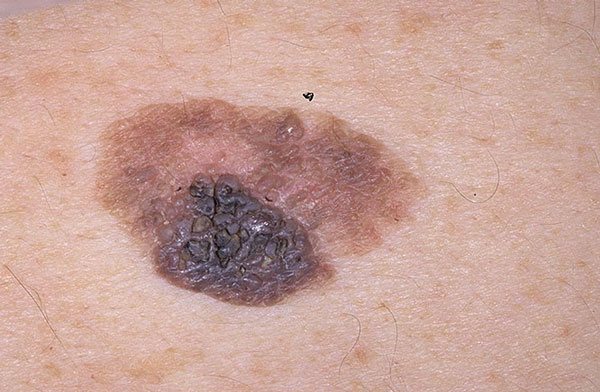
The most common symptoms when a mole can become ill are:
The mole is swollen and painful - on the face, red, what to do, photo
If a mole on your body is swollen and painful, this can be a dangerous sign.
Do not put off visiting a doctor to dispel doubts.
It is rare that a person does not have moles on his body (scientifically, nevi). Usually we rarely pay attention to them, especially if they are located in places that are hidden from view (for example, on the back) or are small in size.
- All information on the site is for informational purposes only and is NOT a guide to action!
- can give you an ACCURATE DIAGNOSIS !
- We kindly ask you NOT to self-medicate, but to make an appointment with a specialist !
- Health to you and your loved ones!
But sometimes the nevus declares itself. You may notice that the mole is swollen, and sometimes experience discomfort in it.
What could this be connected with, and most importantly, is it dangerous and what to do in such a situation? Let's try to answer these important questions.
Types of nevi
A nevus is a collection of skin pigment cells (melanocytes).
vascular moles (hemangiomas)
Depending on where it is localized, the following types of moles are distinguished:
- epidermal - an accumulation of melanocytes forms in the epidermis, the mole rises above the skin and can have a different color and size;
- intradermal - located in the deep layers of the dermis, can rise above the skin, has a bumpy surface, and over time a hanging mole forms in its place;
- borderline - appears in the form of a spot that can stand out slightly above the surface and has clear contours.
Nevi can appear on any part of the body, with the exception of intradermal nevi, which most often form on the head.
pigmented nevus
According to their structure, nevi are:
- vascular - formed from a cluster of blood vessels, and therefore their color is from pink to brown, their shape and size are different;
- not vascular - they are based only on melanocytes, which is manifested in color (from light brown to black).
Vascular nevi often appear on the face, neck and torso, less often on the extremities.
hemangiomas on the face
Why is a mole swollen and painful?
If a mole is swollen, this symptom should not go unnoticed by the owner.
The reasons for this nevus condition can be very different.
Here are some of them:
- trauma – this means any mechanical impact on an existing mole, but most often cuts occur;
- hormonal imbalance in the body is a common cause of changes in nevi - they can swell, itch, and hurt;
- the onset of a malignant process can manifest itself with the following symptoms.
Regardless of the cause, a changed mole requires consultation with a specialist.
After injury
- Moles located on the cheek, legs, and armpits are often injured.
This happens when shaving these areas. In this case, the mole can be cut off completely, incised or cut. At the site of the cut, bleeding can be quite severe (if the location of the mole was the cheek or armpit, where the skin is thinner), but do not be surprised if there was no bleeding at all. - Scratching can cause injury to moles; you don’t have to have long nails to do this.
This happens especially easily after a bath, when all the skin is steamed. If a mole itches, touching it is not recommended at all. - Friction and squeezing of the mole by tight underwear is also a factor in the fact that the mole becomes inflamed.
Injury can occur accidentally, during any activity, for example, if the location of the mole is a hand.
It is better to treat a damaged mole with an antiseptic (for example, chlorhexidine solution) and cover it with a sterile bandage.
After an injury, the mole must be shown to a dermatologist. Only he will be able to correctly assess the situation and give further recommendations.
traumatized nevus
If there was no injury
If the mole has not been injured, then the cause of its swelling and pain may be either hormonal imbalances or the onset of degeneration.
During hormonal changes in the body, you can often notice a slight increase in the size of nevi on the body. During adolescence and pregnancy, you should especially carefully monitor this. In this case, the mole may remain benign, but you should definitely consult a doctor.
If a mole turns red, hurts or itches, this is not yet a sign of its degeneration.
But the formation of malignant processes always occurs with these symptoms.
Tumor development can occur in a nevus for the above reasons and for others. For example, with excess exposure to ultraviolet (sun) rays on the skin. In this case, pain or other sensations will be obligatory accompaniments of visible inflammation.
Of course, the pain will not be as strong as when a tooth hurts , but it will be impossible not to notice it. You can compare it with how your gums hurt: a boring, constant pain of medium or low intensity.
Changes in a mole for no apparent reason (trauma) are the most dangerous. Don't put off your visit to the doctor.
What is the danger
Why, after noticing inflammation of a mole and discomfort in it, is it necessary to urgently schedule a consultation with a dermatologist? The fact is that in this case there is always the possibility of the nevus beginning to degenerate into a malignant formation.
It doesn’t matter how healthy your lifestyle is or how good your health is. Unfortunately, no one is immune from this.
But if you take control of the situation at the very beginning, the risk of unpleasant consequences can be avoided.
Therefore, for the sake of your own peace of mind, health and beauty, you need to consult a doctor. He will prescribe diagnostic measures and determine the status of the changed mole.
Causes of rebirth
Several factors can trigger the process of transformation of a mole into a malignant formation.
But scientists say the main one is exposure to ultraviolet radiation.
In pursuit of a beautiful tan, we often forget about this, especially during the hot season on the seashore. But abuse of solarium also leads to similar consequences.
You are at risk if you have:
- fair skin and hair;
- a large number of nevi on the body;
- many moles larger than 5 mm in diameter;
- New moles appear regularly.
Be sure to limit your time in the sun and protect your skin with special products.
Other reasons for degeneration:
- moles are constantly in contact with clothing and experience pressure and friction (ankles, belt, chest, neck);
- the mole is injured (cut, scratching, thermal burn);
- removing hair from the surface of the nevus;
- removal of nevi in non-medical institutions (as a result of the work of unqualified specialists in this field);
- attempts to independently remove the nevus.
Symptoms
rebirth
You can suspect that a mole has begun to degenerate based on some signs:
- the nevus becomes asymmetrical;
- there is pain, tingling, itching in the mole;
- bulges and irregularities appear at the edges of the mole;
- nevus bleeds;
- the color changes, which may be uneven inside and along the edges of the mole;
- the skin around the mole has turned white;
- the nevus swells and increases significantly in size;
- the mole secretes fluid.
These symptoms do not necessarily reliably indicate that a mole has become malignant.
But if any sign is detected, you must urgently see a dermatologist or dermato-oncologist.
The doctor will be able to more accurately diagnose the condition of the nevus. So, if a mole festers, this may be a sign of an infection, and timely treatment will quickly get rid of this problem.
Features of diagnosis and treatment
When a mole hurts when touched, dermatoscopy - surface microscopy - is used for diagnosis. Deviations are examined under a magnifying glass.
The lymph nodes are palpated. Their increase indicates the malignant nature of the neoplasm.
If cancer is suspected, a biopsy is prescribed. Tissue collection is carried out using one of the following methods:
- The top layers are shaved off (if there is a low likelihood of cancer). This method is not suitable when the mole hurts when pressed.
- Trephine biopsy - deep tissue sampling is done.
- Incisional and excisional biopsy. Used for pain in and around the nevus.
When the disease is confirmed, additional analyzes and tests are prescribed not only on the affected, but also on healthy areas of the body.
So which doctor should you go to if you have discomfort? How exactly to determine which doctor will help? To begin with, you can contact a dermatologist, who, if you suspect a malignant formation, will definitely give you a referral to an oncologist.
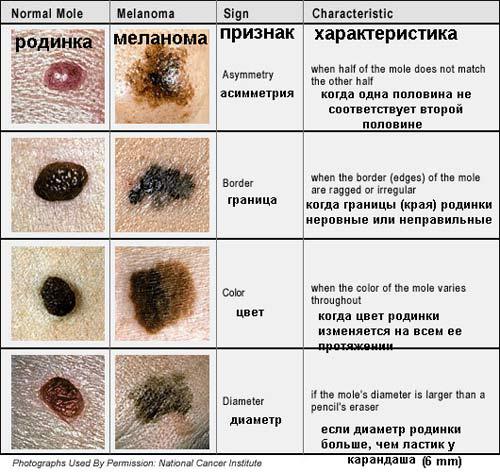
Treatment of painful nevi is carried out only by surgery. After removal, it is allowed to use traditional medicine methods to speed up the healing process.
Sometimes a mole resembles another ailment, which is described in more detail in the article human papillomavirus - what it is and how dangerous it is, which is why differential diagnosis is so important for the manifestation of the final diagnosis.
Differential diagnosis determines multiple variations in the sampling of small particles of growth or the entire nevus. It should also be taken into account that damaged areas of skin and scars remain.
The choice of an effective method depends entirely on the actual size, shade and source of inflammation; sometimes it is not suitable for moles on the face.
A clinical situation when a patient comes with complaints that the skin around a mole hurts suggests its complete removal. At the time of the operation, as much of the pathologically altered tissue that is located nearby is removed.
The material is collected using the following well-known methods, which we will consider further.
Removal of biological material tangentially
In practice, it is used when the growth rate is low. Using a small scalpel, the doctor scrapes off the top layer, the outer part of the epidermal layer. The method is not used if the mole hurts when pressed hard.
Then it is necessary to excise too much living tissue according to the depth of the growth. If melanoma is confirmed, then such a biological fragment will not be enough to establish the full clinical picture of the disease.
Why does pain occur in a mole?
It is difficult to find a person who does not have moles on his body.
Doctors call these noticeable growths nevi and classify them as tumors. Most moles are benign. Why does a mole hurt and what to do if a symptom occurs? The appearance of pain is often a consequence of injury or mechanical damage, or may arise due to the development of pathological processes. In some people, the symptom is associated with the formation of a cancerous tumor - melanoma.
In all cases, it is recommended to visit a medical facility for consultation and examination.
What factors can provoke pain in a mole?
When examining a newborn baby, you can notice moles on his body - such nevi are congenital. They are often hereditary. Over the course of a person's life, new moles may appear. The prerequisites for their occurrence can be associated with various events :
- injury to the skin and soft tissues;
- exposure to direct sunlight;
- increasing radiation levels;
- changes in hormone balance;
- damage to the body by infection or viruses.
© shutterstock
Experts name two groups of reasons when pain appears in a mole - exposure to external stimuli and internal causes. Pain in a mole is also observed if there is an impact on the formation itself, nearby nervous tissue, blood vessels, sweat or sebaceous glands, and hair follicles.
Usually a mole begins to hurt if its owner suffers injury. Rubbing with clothing, careless hygiene procedures, blows, cuts, any burns, or pricks with a sharp object cause damage to the integrity of the nevus.
Its membranes are destroyed, the endings of the nerve tissues lose their protection, so pain appears. The symptom may be associated with changes in body or environmental temperature. Its fluctuation accompanies many diseases. Nevi hurt when the functions of internal organs or endocrine and gonads are impaired.
You should familiarize yourself with the common reasons when a mole hurts in more detail.
Mechanical injury
A mole hurts when touched if its tissue has been mechanically damaged. The nevus is injured in different ways - it can be rubbed when wearing clothes or shoes, its tissues are damaged by cuts, bruises, and punctures with sharp objects. A mole on the head may begin to hurt after washing and combing your hair, changing your sleeping position, or wearing a hat.
© shutterstock
A hanging mole or one that protrudes above the surface of the skin often hurts. Any injury involves a violation of the integrity of the tissue - pain in the mole occurs for this reason.
There is a great danger of developing inflammation, because microbes, viruses, fungi can enter a damaged nevus from the environment and begin active reproduction. To prevent infection from occurring, you need to see a doctor.
Depending on the situation when the mole was injured and pain occurred, experts advise such actions:
- if a mole is completely torn off, it cannot be thrown away, it must be saved for research;
- the wound should be treated with an antiseptic agent and carefully covered with a sterile bandage;
- For most patients, if the integrity of the nevus is damaged or pain occurs, it is necessary to completely remove its tissue and conduct the necessary tests.
In addition to surgical removal of the mole after its injury, additional treatment is necessary. The patient is prescribed painkillers and anti-inflammatory drugs.
Melanoma formation
Sometimes a person may notice that his mole is growing and hurting, and other metamorphoses are occurring with it. Such changes may indicate a dangerous degeneration of an ordinary nevus into melanoma - skin cancer. A cancerous tumor can grow deep into the tissue or into the superficial layers of the skin. The process is characterized by rapid spread and active formation of metastases.
© shutterstock
An ordinary, “harmless” mole can become melanoma and become very painful in several cases. Provoke the degeneration of nevus cells (melanocytes) into cancer hazards :
- damage to a mole of a mechanical nature, injury when its structure is disrupted;
- active exposure to ultraviolet radiation;
- genetic predisposition, presence of melanoma in close relatives;
- changes in the body of a hormonal nature, the most dangerous are adolescence, pregnancy, menopause, the presence of pathologies of the endocrine system;
- decreased immune defense;
- the presence of a large number of moles on the body;
- bright skin.
The transformation of moles into melanoma is observed in people belonging to the middle and older age groups. According to statistics, this type of cancer often develops in men.
https://www.youtube.com/watch?v=4q_FgHF7-II
The main sign indicating the presence of melanoma is pain - the mole hurts when pressed and without such pressure. The spot becomes asymmetrical, has an uneven color, with darkening and light areas . Its edges become ragged or fuzzy. The mole rises noticeably above the surface of the skin.
Its structure becomes loose, bleeding and pus appear, and crusts form. There is a burning sensation and pain around the mole, which intensifies over time.
In advanced stages, when cancer is accompanied by metastasis, a person rapidly loses weight, his lymph nodes enlarge, his skin becomes gray, his head hurts severely, and a persistent cough appears.
The presence of pain in a mole against the background of its structural changes cannot be ignored. You should contact a medical facility immediately. To diagnose melanoma, a visual examination of the nevus is used, and tests of the patient’s blood and urine are performed.
A tissue biopsy (excisional and incisional), a cytological examination of lymph node puncture, and instrumental studies to identify changes in internal organs are required.
The doctor assesses the depth of tissue damage by the tumor using infrared radiation.
If a mole has enlarged and hurts and causes discomfort, you must not allow it to degenerate into melanoma. The nevus needs to be removed.
The procedure uses gentle methods - surgery using a laser or radio waves, removing the mole with a scalpel and capturing damaged tissue. If the diagnosis of melanoma is confirmed, courses of chemotherapy and immunotherapy are necessary.
The prognosis for the patient directly depends on the stage at which melanoma was detected and the formation was removed.
Exposure to ultraviolet radiation
A symptom where birthmarks hurt may indicate the negative effects of ultraviolet radiation. For pain to occur, a person does not have to deliberately lie for a long time and regularly on the beach or sunbathe - just walking down the street, working or relaxing in the open air is enough.
© shutterstock
Ultraviolet radiation usually affects moles that are located on open areas of the body - arms, face, legs, neck.
The appearance of pain in the nevus itself, redness of exposed skin, severe itching and burning, increased body temperature, weakness and signs of fever directly indicate that the person has been actively exposed to ultraviolet radiation. The mole may become inflamed.
If the pain persists, you should contact the clinic. After an examination, the doctor may decide to remove the nevus. After surgery, he will prescribe anti-inflammatory treatment and medications to relieve pain.
During the period of active sun, you need to wear clothes and hats that hide areas of the body with moles. It is necessary to use sunscreens or sprays and limit exposure to the street during dangerous hours.
Increasing the size of a mole
Pain in a mole can occur when it is actively growing. When it increases in size, its cells quickly divide, grow, and affect the nerve endings in the skin and soft tissues, squeezing them.
Any rapid growth of a nevus should alert you - an increase in the size of a mole in a short period of time may indicate its degeneration into a malignant tumor.
Therefore, visiting a doctor immediately is very important.
© shutterstock
Pain in a mole as its size increases is typical for several situations.:
- development of the process according to a malignant “scenario”;
- the presence of diseases of the endocrine system;
- the appearance of hormonal imbalance during pregnancy, age-related female changes;
- after treatment with hormonal drugs;
- in case of injury or exposure to dangerous ultraviolet radiation.
The doctor conducts an external examination of the patient and decides on the choice of instrumental diagnostic method - cytological analysis, tomography. A blood test is ordered to check for the presence of tumor markers. The problematic mole is removed.
Change in air temperature
There are a huge number of nerve endings on the human skin. Changes in ambient temperature negatively affect moles and can cause pain in them. The temperature regime that is comfortable for humans corresponds to approximately 20 degrees Celsius.
Unfortunately, such indicators are observed for a short time. In the summer there is a noticeable increase in the indicator, and in the autumn-winter there is a significant decrease. The skin takes an active part in the process of thermoregulation.
When the temperature changes dramatically, the skin tissues and moles located within them experience stress and pain.
© shutterstock
When the situation persists and there is pain in the moles, which can intensify when pressed, you need to consult a doctor. He will conduct a visual examination of the patient, and if there is a change in the structure of the nevus, he will prescribe an additional study - a biopsy of its tissue. Often a decision is made to remove a growth or several.
Other causes of pain in a mole
According to statistics, the most common cause of pain in a mole is its trauma. One of them is a chemical burn. In everyday life - at home, at work, people often come across chemicals - acids, alkalis. When they come into contact with the body, the mole becomes very painful and inflamed.
Some cosmetics have an aggressive effect (usually a mole on the face hurts). The symptom may occur as an allergic reaction to the components of the serum, cream, oil that are used in the procedures. A mole on the back often hurts when performing a massage.
Pain occurs after mole removal. To prevent it, you should follow the rules :
- avoid any damage to the skin;
- do not wet the area where the intervention was performed until the tissue heals;
- avoid direct exposure to ultraviolet radiation;
- use medicinal and cosmetic products prescribed by a doctor.
Which doctor should I contact?
The causes of pain in the mole are determined by a specialist. If a symptom appears, a visit to the clinic should not be postponed - any nevus under unfavorable conditions can transform into melanoma. The oncological process in this case has a very high development rate and is difficult to treat in advanced stages.
If a mole starts to hurt, you need to make an appointment with a dermatologist. After the initial examination, if indicated, he may refer the patient for an appointment with specialized specialists - an oncologist or a dermatologist-oncologist.
© shutterstock
When pain in a mole is especially dangerous
If a person notices that his mole hurts, the symptom occurs periodically or constantly, he must undergo a medical examination. Particularly dangerous are situations when the main manifestation is pain, accompanied by others :
- the mole noticeably grows (in width or upward), takes on an asymmetrical shape, one of its parts becomes larger;
- the usual outlines of the growth will change, its edges will become uneven, “torn”;
- change in the color of a mole or its sections, coloring it in an uneven shade, the appearance of bright areas (very dark, light, bluish, red);
- the mole becomes very dry, its tissues crack;
- redness and pigmentation begin to appear in areas of the skin around the nevus;
- active appearance of several new ones next to the mole that hurts;
- severe itching of the mole, bleeding from its body, wetting of the surfaces, formation of a crust on the surface, suppuration.
Paying more attention to all moles, especially those that hurt, monitoring and assessing their changes allows you to identify dangerous pathologies and begin treatment in a timely manner.
Source: https://PrichinyBolej.ru/1893-pochemu-voznikaet-bol-v-rodinke.html
What tests should you take if a mole hurts?
When a patient indicates that a mole is growing and hurting, a comprehensive medical diagnosis is performed. If oncological transformation is suspected, the dermatologist should prescribe the following additional study - tissue biopsy.
The skin sample is removed and sent to the laboratory. The procedure is performed under local anesthesia.
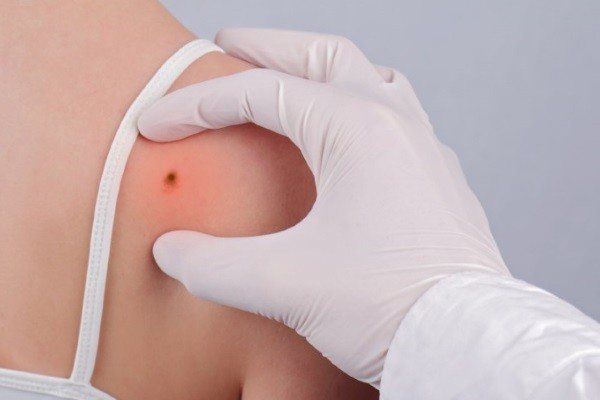
Various options for collecting a particle or a whole nevus are determined. But keep in mind that they all leave scars. The choice of method depends on the size of the pigmentation and the inflamed area.
A situation where a patient complains that there is pain around a mole involves removing as much pathological and nearby tissue as possible in order to establish a more accurate and definitive diagnosis.
Sample collection is performed in one of the following ways:
Tissue collection tangentially:
Used when there is a very low probability of cancer. Using a small surgical scalpel, similar to a razor, the doctor shave off the upper layers - the epidermis and the outer part of the dermis.
The method is not suitable if the mole hurts when pressed, because then you need to remove a lot of tissue deep into the formation. And the razor blade doesn't go deep enough to reach the end of the suspect area.
And if melanoma is nevertheless confirmed, such a sample will not be enough to display the full picture of the disease and establish an accurate diagnosis.
Trephine biopsy:
The doctor operates with an instrument similar to a circular cutter. It is able to penetrate the skin structure as deeply as required.
Incisional and excisional biopsy:
It is carried out in cases where not just the mole itself is inflamed and hurts, but also other areas (for example, it hurts under the mole):
- with the incisional method, part of the formation is removed. Using a surgical knife, the doctor cuts through the entire thickness and nearby areas to represent the whole picture;
- The excision technique involves cutting out not a particle, but the entire formation. This option is preferable for oncologists, but is not always feasible due to the difficulty in locating the nevus.
Treatment and treatment methods
After damage, care for a birthmark is the same as for an injury. If the inflamed mole is swollen, treat it with an antiseptic solution (hydrogen peroxide) and apply a bandage.
Diagnosis and treatment of neoplasms are carried out by oncologists and dermatologists. The doctor determines the advisability of removing the seal. Treatment methods are used.
| Method name | Description |
| Surgical | Removed with a scalpel in a hospital setting. The method is rarely used due to prolonged healing and the likelihood of a secondary infection. |
| Cryodestruction | Freezing treatment, applying a layer of liquid nitrogen. The disadvantage of this method is damage to healthy skin cells. |
| Laser removal | The laser is applied to the area of the birthmark. The method allows you to quickly and painlessly remove tumors. The removal process takes a few minutes and healing time is minimal. |
| Radio wave method | Removal using the Surgitron device (radio knife). |
| Electrocoagulation | Exposure to high frequency electric current. The operation is performed under local anesthesia. The advantages of the method are that cell histology can be performed to distinguish malignant pathology. |

Prevention of cell degeneration
- To prevent the development of inflammatory processes and malignant degeneration of nevi, it is necessary to regularly examine them yourself for changes in size, color, and redness of the mole itself or the skin around it.
- You should not wear uncomfortable clothes that can have a mechanical effect on existing nevi. To reduce the negative effects of sun rays, it is necessary to use products with SPF.
- If pathological signs are detected (even if the mole does not enlarge, but there is prolonged redness or swelling), you should not treat yourself at home with medicines little known to you or, especially, with folk methods. You need to contact a specialist for a full examination and treatment.
- As a preventative measure, experts recommend visiting a dermatologist or oncologist at least once a year for monitoring.
- Monitor any changes in skin lesions.
- If a pigmented formation is damaged, be sure to treat the wound with hydrogen peroxide.
- If you have a lot of large or hanging moles on your body that could be accidentally damaged, your doctor will advise you to remove them.
- It is better to cover those formations on the skin that you do not want to remove when sunbathing.
Post Views: 1,090
Causes of mole swelling
Nevi located in inconvenient places (armpits, neck, area between the shoulder blades, forearm, spinal area, back of the hands, face) swell and inflate.
Reasons for changes in birthmarks:
- Mechanical impact (trauma). Occurs when shaving, squeezing by tight clothing (bra fasteners), or accidentally scratching with nails (after a bath, steam room).
- An attempt to remove hair from a tumor.
- Hormonal imbalance in the body (during pregnancy, menopause).
- If an inflamed mole is swollen and hurts, it may degenerate from a benign neoplasm to a malignant one.
- Ultraviolet radiation after prolonged exposure to the sun.
- The result of self-removal of a nevus or removal of a neoplasm in a cosmetology, not a medical institution.
What to do if a hanging mole becomes inflamed
The appearance of hanging moles.
Every person has moles on their body, but some are practically covered with a wide variety of moles, while others can count their nevi on one hand. In fact, moles are simple cells of our skin, which over time and over a number of factors have darkened due to the pigment accumulated in the cells. Moles most often appear during hormonal changes, i.e.:
- when a child grows up,
- if a boy or girl is going through adolescence,
- when a woman carries a child in her womb,
- during times of extreme stress, etc.
However, for the most part, many people are interested and pay attention not to simple moles, but to hanging moles. These moles are very strange - if these are skin cells, then why did they begin to “hang” over the skin, why do hanging moles appear? In fact, many people classify small hanging moles not as nevi, but as papillomas, which are also benign formations on the body. Most often they appear on the body in those places that are more mobile and more often exposed to direct sunlight. Here are some special factors that can be identified as the causes of hanging moles on the body:
- human papilloma virus;
- oncological diseases;
- genetic predisposition;
- excessive sun exposure;
- malfunction of internal organs.
Don't be afraid that a mole has suddenly appeared for the first time, although you have never had such moles before. The peculiarity of the existence of such moles on the body is that they can disappear on their own, and you won’t notice it right away.
ATTENTION! Here's something to remember: Hanging moles are worth keeping an eye on. To do this, you can conduct regular examinations of your own body or contact a dermatologist-oncologist.
Many people decide to remove moles because they cause inconvenience and discomfort and can make one’s appearance repulsive. However, there are also medical indications for the removal of hanging moles, in which case removal is simply necessary urgently.
Is there any danger in hanging moles?
Any moles and papillomas are not dangerous, but you have the risk that one of the neoplasms will begin its terrible degeneration. Benign neoplasms degenerate into malignant tumors. As you understand, this is extremely serious and can lead to complications and big problems if the situation is not corrected in time. So you will have to visit the office of a dermatologist-oncologist so that the doctor can confirm or refute your doubts about hanging moles. But you can yourself, by daily examining the moles on your body, determine whether there are any problematic moles among all:
- Listen to your body - if any of the hanging moles hurt;
- Carefully inspect the moles externally, especially in the most dangerous places - if the hanging mole under the arm is inflamed, it means that you cut or touched it while shaving. Also examine hanging moles on other parts of the body to detect inflammation;
- The mole should not itch or itch, because... this is dangerous due to injury to the mole and may indicate the beginning of the process of the appearance of a malignant tumor;
- Inspect the area around the mole - there should not be any “halo” nearby, which may resemble a flat mole;
- Press on the mole - there should be no compaction or discharge. If an unknown fluid or blood is released from a mole, this is a very bad symptom.
If you identify at least one suspicious factor, you should consult a doctor, despite the fact that there are very few cases of degeneration of hanging moles, you should not risk falling into the “chosen circle”. Believe me, the consequences are extremely negative; you will have to not only remove the mole, but also all the malignant cells that have managed to increase in size, undergo a course of treatment, and much more.
Favorite places for hanging moles.
As you know, moles can appear on anyone, they can either appear on the body or disappear. However, it is possible to identify special places for hanging moles, where they prefer to appear most often:
- neck,
- back,
- groin area and genitals,
- armpit area.
Hanging moles in the groin cause the least discomfort, because... Each person monitors this area as much as possible; this area is less susceptible to friction and scratching, which means that the likelihood of touching a hanging mole in this place is low. However, this does not apply to cases where you prefer to shave hairs from the bikini area or from the entire groin area, then there is a danger of shaving off a completely hanging mole.
Hanging moles under the armpits are also dangerous - most often they are touched while shaving hairs. It is hanging moles in the armpits that are recommended to be removed first, for both women and men. Moles in this area are often at risk from the simple process of changing clothes if you wear tight-fitting clothes.
Particular attention should be paid to hanging moles on the neck. Men often shave the growing hairs in the neck area (both front and back). But if this is done using a mirror, i.e. If you can avoid problems, then what about itching? Itching in the neck area is normal; it can be caused by rubbing clothes, touching hairs, blowing wind, and other minor circumstances. For this reason, we often scratch our neck and can damage hanging moles on it.
One of the harmless hanging moles are moles on the back. They are least likely to get picked or scratched, but can be rubbed on by everyday clothing. In this case, it is recommended to either remove moles on the back, or start wearing loose clothes that do not rub when worn and do not interfere with dressing.
How to remove hanging moles.
It is worth removing hanging moles for several reasons:
- If hanging moles cause discomfort,
- If hanging moles spoil your appearance,
- If the doctor has prescribed removal of a hanging mole for medical reasons.
Many people doubt what to do if a hanging mole becomes inflamed or torn off. First of all, you need to contact a dermatologist or oncologist, who will check a hanging, inflamed or scraped mole. As a rule, the doctor will either give you recommendations that will help you avoid injuring hanging moles on the body, or will direct you to remove the mole. If mole removal is aimed at your healing, then you will be given:
- Surgical excision of a mole. The operation is anesthetized and takes no longer than an hour. During it, the surgeon cuts through the mole with a scalpel, excises dangerous cells and takes away a little of the healthy areas. Healthy cells along with malignant ones are necessary for cell examination, because After removing a mole, it must be sent for a biopsy. This method is less attractive for the patients themselves, because takes more time and leaves marks. But don’t be alarmed, you can remove the marks from this method with a plastic surgeon by resurfacing the scar.
If the doctor has not given any special medical indications, then you can use methods that are more skin-friendly. For example, one of the best ways to remove moles and papillomas:
- Laser removal of hanging moles. The operation is performed within a few minutes, the surgical area is preliminarily anesthetized, and during the operation itself there will be no bleeding - this is one of the advantages of this method. It is also worth noting that after laser removal of moles, no traces remain on the body after a couple of weeks, and at first a small hole from the excised area remains.
There are many more methods for removing moles, but each of them has a number of disadvantages that are not identified with either surgical or laser removal of moles.
vip-hirurg.ru>
What is a mole?
First, let's figure out what a mole is and what danger it poses to its owner. A mole is a formation on human skin that appears as a result of an excess of melanin in skin cells.
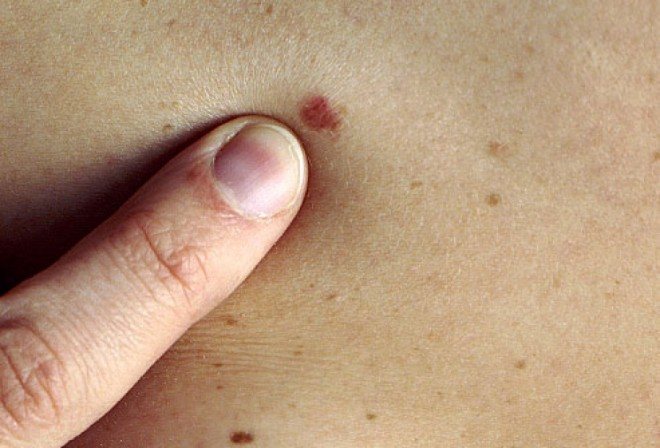
Initially, a mole is a benign formation. However, over time and under unfavorable circumstances, it can degenerate into a malignant tumor. This is why you should treat moles with extreme caution.
Kinds
There are several types of moles.
By color:
- red;
- white;
- black.
And in form:
- convex type;
- flat type;
- hanging;
- round;
- asymmetrical.
A benign neoplasm may not cause any discomfort or pain for many years. But this does not mean at all that a seemingly harmless mole cannot develop into melanoma.
Melanoma is a malignant tumor, the seriousness of which comes down to its rapid growth and the penetration of infected cells into the deep layers of tissues and internal organs. Prompt removal of moles will reliably protect against life-threatening melanomas and metastases.
We also advise you to read this article: “Causes of the appearance of moles on the body.”
Why do they appear?
Since birth, our body is covered with moles and age spots. This is a genetic predisposition. But over time, moles become larger and the following factors contribute to this:
- excessive exposure to ultraviolet radiation on beaches and solariums;
- menopause;
- hormonal changes when taking hormonal medications or pregnancy.
You should get rid of moles that have a convex structure as soon as possible. This can be done at any time of the year. After removal, you should check the mole for cancer. Histological examination will help determine the type of tumor - benign or malignant.
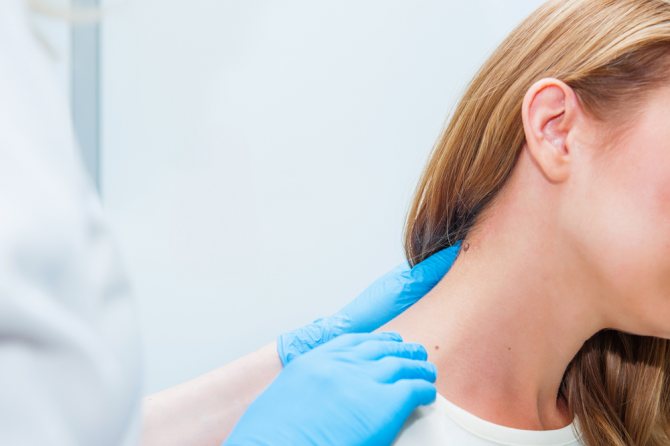
Causes
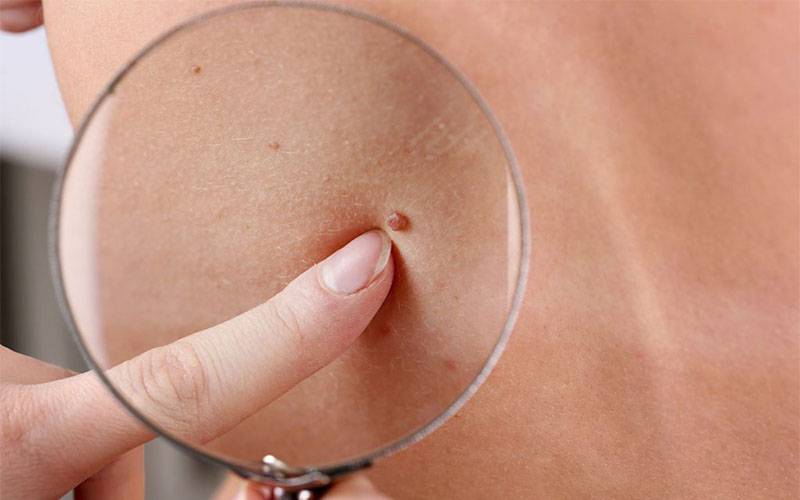
So, what should you pay attention to first? Nevi often appear due to weakened immunity. The etiology of hanging moles has not yet been fully studied. They appear in each person for different reasons, depending on individual factors.
These include:
- slagging of the body;
- changes in hormonal levels;
- age-related processes;
- ultraviolet radiation;
- weakened immune system;
- genetic predisposition.
Women may develop hanging moles during pregnancy. The reasons for this are associated with significant changes in the functioning of the endocrine system and hormonal imbalances.
Folk remedies
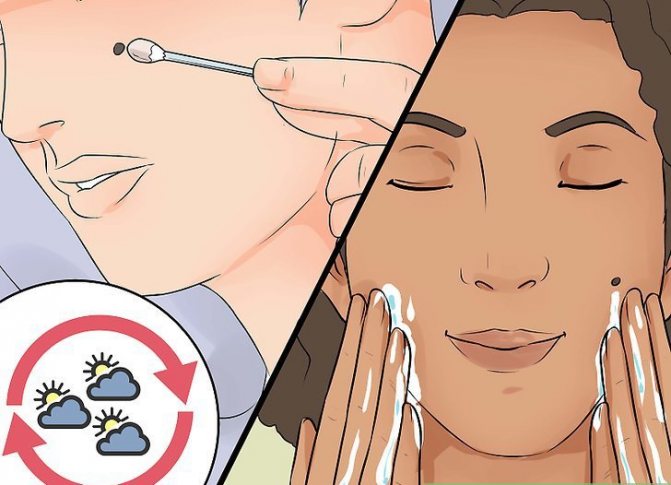
Is it possible to remove hanging moles at home? This question is of particular interest to adherents of traditional medicine. There are several proven methods using which you can easily remove a mole without visiting a dermatologist's office.
Here are just a few of them:
- Regularly lubricate the formation with iodine or celandine. This treatment helps burn the mole to the ground. Over time, education will disappear on its own.
- Bandage the base of the mole tightly with your hair and leave it in this state until it falls off on its own.
- You can use a special pharmaceutical product to remove hanging moles.
When choosing a product to remove this aesthetic defect, it is especially important to adhere to the basic recommendations for its use. Experts do not recommend using aggressive chemicals to burn out this defect. The effect on the body can be negative.
